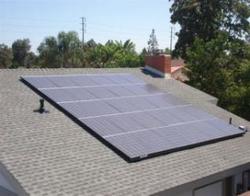A home solar panel can seems pretty magical to people today.
Like our ancient ancestors mesmerized by a solar eclipse, we watch in awe as those rooftop panels turn sunlight into electricity.
Although we may admire what a solar panel can do, most of us don’t really know the history of solar panels or how they work.
All we know is that if we put a solar panel on our roof and the sun shines on it, it can make our electric meter go backwards.
Well, that’s a good start.
And don’t worry if you don’t have a clue about solar panels because you’re not alone (and you’re definitely in the right place!).
Let’s make sure you’re up to par with your solar knowledge by taking a quick look at where solar panels come from, how they work, and what they can do for you.
First off, let’s get a little background information on our faithful hero, the solar electric panel:
The ‘photovoltaic effect’ which allows solar cells to produce electricity from sunlight, was discovered in the nineteenth century.
Solar cells were made with selenium until 1953 when the more efficient silicon was used instead.

This made solar panels more efficient but unfortunately at $300 per watt they were still too expensive to be used as a power source.
This all changed during the ‘space race’ when scientists needed a power source for earth orbiting satellites and solar panels started to look pretty good.
As the technology improved the price came down and solar cells were used to power loads in remote locations on earth like lighthouses and buoys.
Solar prices are now competitive with traditional energy sources in many areas of the world.
There you go: A quick version of how the miraculous solar panel made its way to rooftops in your neighborhood.
Now let’s take at how solar electric panels work their magic:
Solar cells are made from semiconductor material like silicon which is treated so it has a positive charge on one side and a negative charge on the opposite side.
Light energy from the sun knocks electrons in the solar cell loose and the electrons are captured in the form of an electric current.
This current can then perform work like lighting up a light bulb or powering a fan.
I told you we would keep this simple!
I also said that we would take a look at what a home solar panel can do for you, so let’s take a quick look at:
Home Solar Power
As we mentioned before, solar panel prices have been coming down for a long time.
Now the cost of solar panels is low enough to make them a competitive source of electric power.
So, what’s the catch?
Well, so far installing solar panels is usually only cost effective with government rebates and incentives.
The reason for this is quite complex, but suffice it to say that governments have been subsidizing the oil, coal, and nuclear industries for decades and solar power needs government money to level the playing field.
If more people install solar panels, however, an economy of scale should kick in and bring the price of panels down further. Hopefully governments can then scale back their subsidies and solar power will stand on its own two feet.
If you’re considering going solar, your first step should be to check out which solar power rebates are available to you. This is the best way to know what a home solar panel can do for you and your power needs.
